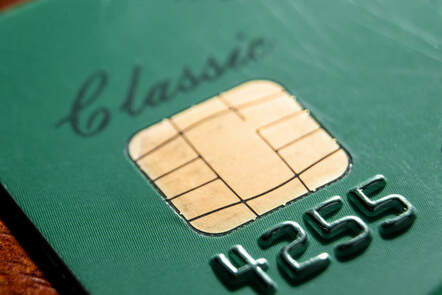 Recent data breaches and identity theft reports have heightened consumer aware-ness around the security of payments. Consumers may find themselves asking, “How can I better protect myself and my personal financial information?” EMV cards, also known as chip cards, allow consumers to conduct all of their daily card transactions with added security features to protect their information. And more than likely, EMV cards are coming to a bank near you soon. What is EMV?
EMV—an abbreviation for Europay, MasterCard and Visa—is an internationally adopted payments standard that utilizes microchip technology to authenticate and process debit card and credit card transactions. EMV cards contain an embedded microchip that provides stronger security features not possible with traditional magnetic stripe cards. Why is EMV so important? Simply put, chip cards are more secure. By using the chip technology instead of traditional magnetic stripe technology, chip cards offer enhanced protection of cardholder information while also reducing fraud resulting from counterfeit, lost and stolen cards. For example, fraud from lost and stolen cards was cut in half when chip cards were introduced in the U.K. Convenience while traveling internationally is an additional benefit of chip cards. Many other countries have already adopted the EMV standard so you can easily use your chip card when traveling abroad. And not to worry, make your online purchases with your chip card in the same way you use a magnetic stripe card. So, what’s different? For now, chip cards still feature a magnetic stripe so they work on all payment terminals and ATMs. However, using your chip card will mean a slightly different experience at the checkout counter. To help remember some key points about using a chip card, think CHIP: Carry your chip card with confidence. By storing your card’s data on a chip, your account information can be changed dynamically with every use, making it nearly impossible for fraudsters to successfully copy. This is a big advance from magnetic stripe cards. Harness its security advantage. Chip cards protect against fraud resulting from counterfeit, lost and stolen cards by providing strong transaction security features not possible with traditional magnetic stripe cards. Insert your card in the terminal. Rather than swiping a traditional magnetic stripe card, cardholders will insert or “dip” a chip card into the reader where it will stay for the duration of the transaction, similar to the way most ATMs work today. Although your chip card still has a magnetic stripe to accommodate older terminals, newer terminals with a chip reader will prompt you to insert your chip card instead. Pocket your card when done. Don’t leave your card behind! Since your chip card will remain in the terminal during the transaction, remember to take your card after the transaction is completed. While chip cards offer a higher level of security, current magnetic stripe cards will continue to be secure, especially if you keep your PIN a secret. Be sure to monitor your card activity regularly and immediately report lost or stolen cards. For more information about EMV, chip cards and how to get yours today, contact your local community bank. This information is provided with the understanding that the association is not engaged in rendering specific legal, accounting or other professional services. If specific expert assistance is required, the services of a competent, professional person should be sought. Provided as a public service by the Pennsylvania Association of Community Bankers. Comments are closed.
|
AuthorWrite something about yourself. No need to be fancy, just an overview. Archives
December 2017
Categories
All
|
|
Pennsylvania Association of Community Bankers
800 N. 3rd Street, Suite 304 Harrisburg, PA 17102 Phone: (717) 231-7447 [email protected] | sitemap (C) All Rights Reserved Our Privacy Policy Our Copyright Policy |
"To empower community banks to make positive impact within the communities they serve."
|
